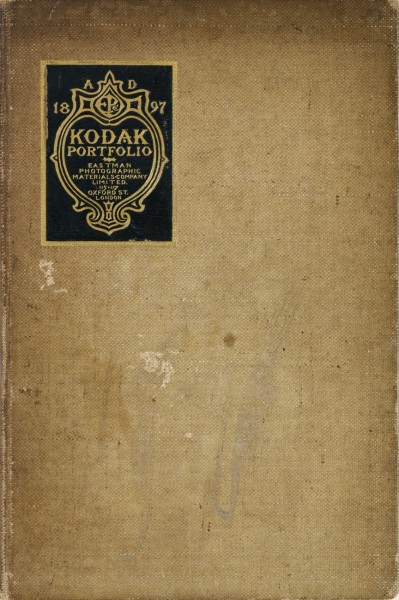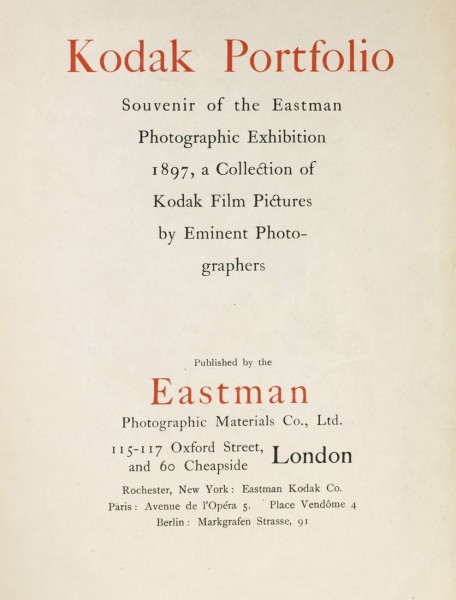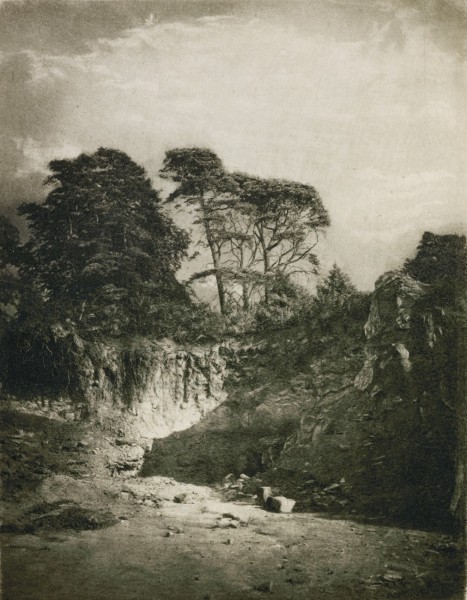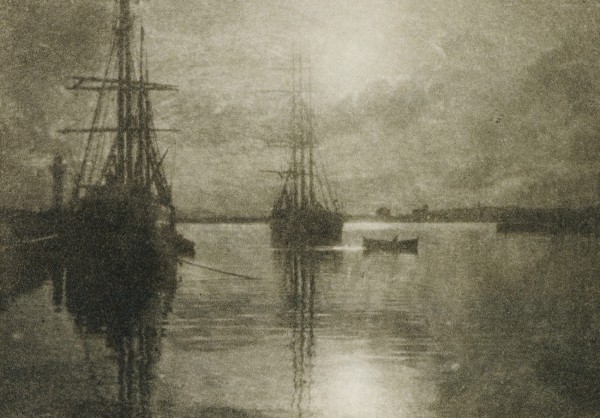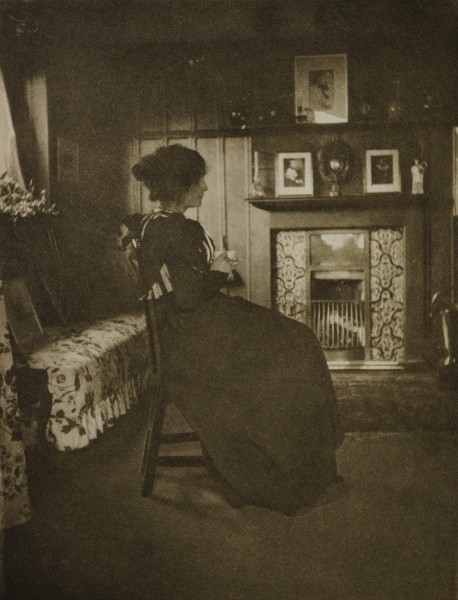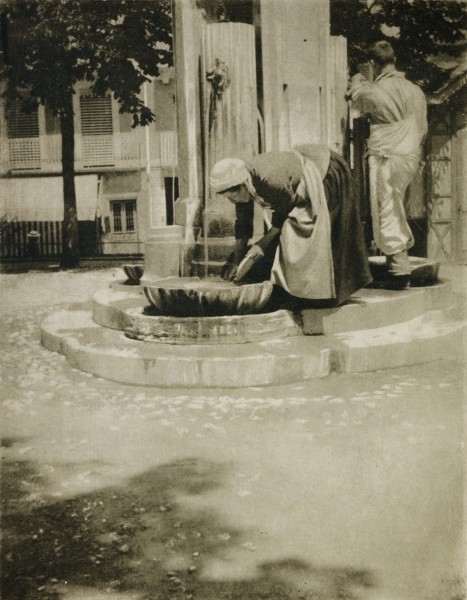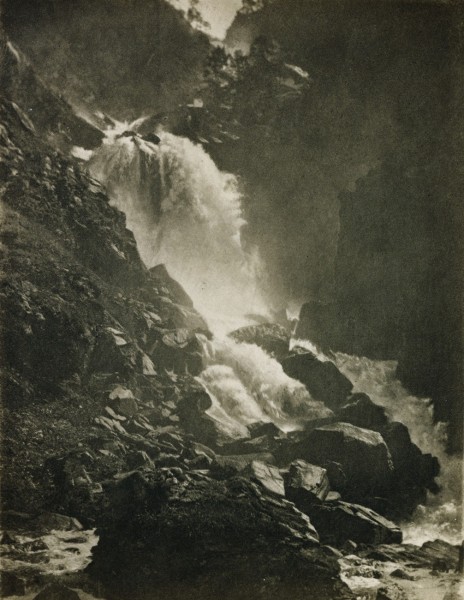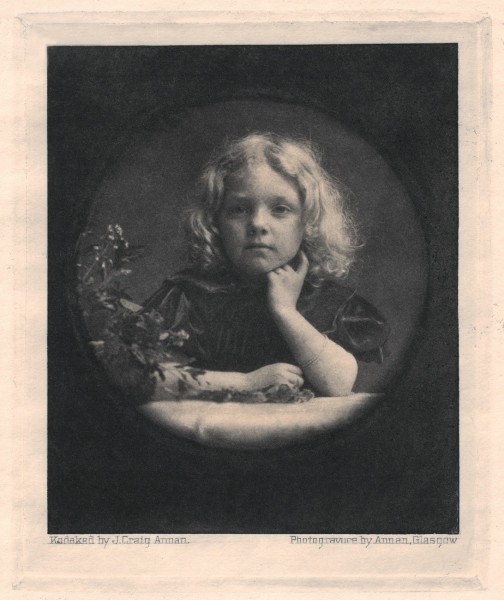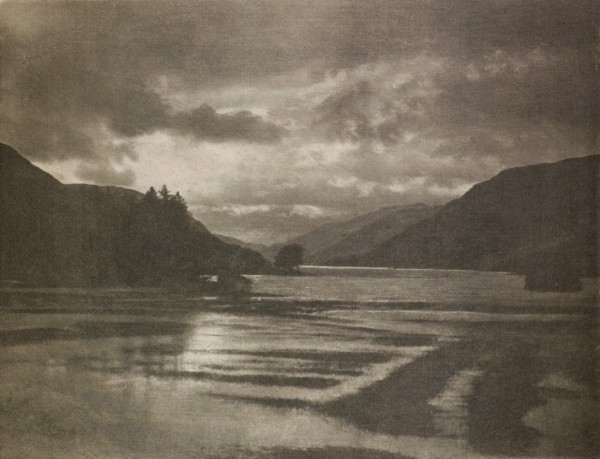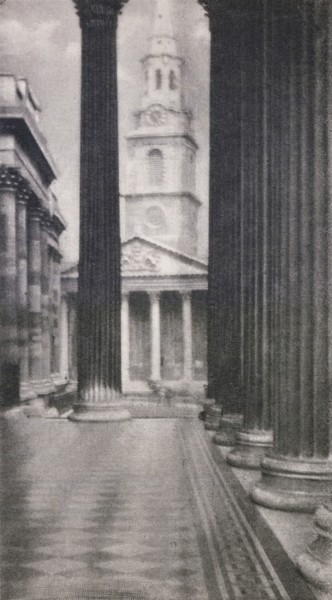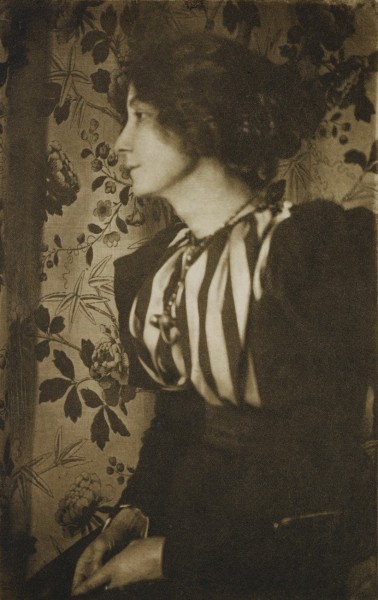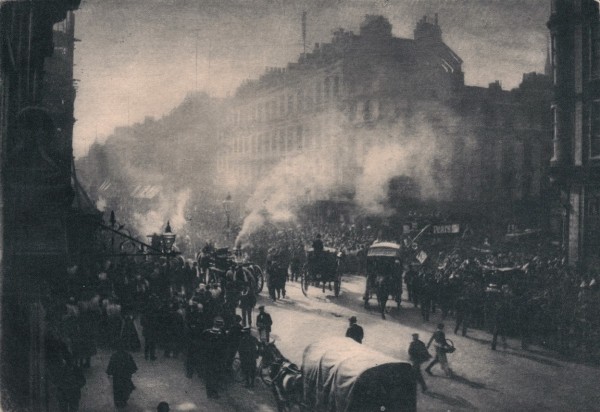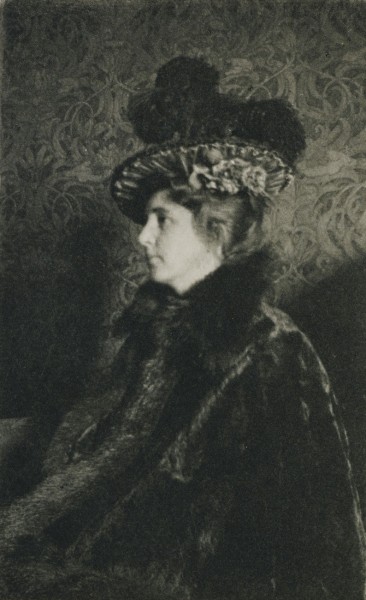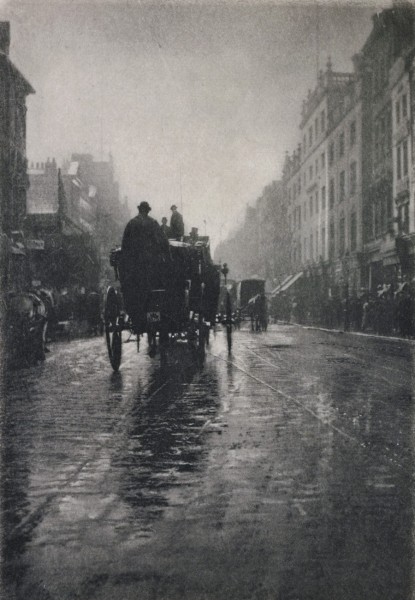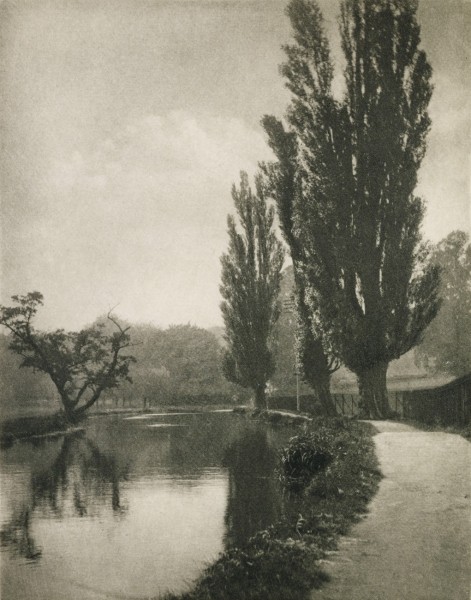Kodak Portfolio: Souvenir of the Eastman Photographic Exhibition 1897PhotographersJames Craig Annan, Eustace Calland, George Davison, Alfred Horsley Hinton, Frances Benjamin Johnston, Andrew Pringle, Henry Peach Robinson, Adolphus H. Stoiber ArtistDavid Young Cameron CountryScotland, England, United States MediumCloth over Boards, Leather: Stamped, Letterpress, Photogravure PortfolioKodak Portfolio: Souvenir of the Eastman Photographic Exhibition 1897 AtelierUnknown, James Craig Annan (Glasgow) Year1897 View Additional Information & Tags Introduction: The Kodak Portfolio book of 1897A commemorative exhibition book titled Kodak Portfolio - Souvenir of the Eastman Photographic Exhibition 1897, a Collection of Kodak Film Pictures by Eminent Photographers showcased the work of recognized pictorial photographers. Hand-pulled photogravure plates on Japan paper were executed for the volume by noted Scottish photographer James Craig Annan, whose work featured prominently in it. All of the photogravure plates from this 1897 volume are presented with this online gallery. Read More Background of the Kodak ExhibitionThe preface to the souvenir volume states the aims of the 1897 Kodak exhibit with other particulars:
“This edition de luxe of 14 photographs by eminent photographers is a souvenir of the Eastman Photographic Exhibition, held at the New Gallery, Regent Street, London, from 27th October to 16th November, 1897. It is aimed chiefly to exemplify some of the pictorial applications of the Kodak and film photography.
The pictures, without exception, are Kodak film pictures, and the assortment is specially arranged to illustrate a few of the various classes of subjects which can all be effectively exploited by Kodak photography.
Landscape, seascape, architectural pictures, portraiture pure and simple done at home, portrait head and shoulders, portraiture of three-quarter figure, portraiture of the whole figure with drawing-room surroundings, will be found pictorially exemplified in this little volume.
We wish to express our hearty thanks to the eminent photographers who have kindly lent us their film negatives, from which the fine reproductions have been made by Mr. J. Craig Annan, of Messrs. Annan & Sons.
The design stamped upon leather on the cover is by Mr. D. Y. Cameron.” 1.
In 1897, the creeping global colossus known as the Eastman Kodak Company in America and the Eastman Photographic Materials Co., Ltd. in England hitched their wagon to the growing interest in international photographic exhibitions by putting on the largest one of its type that year in London. The following year, the London exhibit became a traveling one. With additional material, it was mounted in the galleries of New York’s National Academy of Design in early 1898. Alfred Stieglitz, an outspoken critic of Kodak’s “You Press the Button-We do the Rest” marketing campaign of the era, was compelled to enter work in the National Academy show and may even have provided suggestions for the show’s layout. 2.
Organized by prominent English pictorial photographer George Davison, (1856-1930) himself a founding member of the British Linked Ring and perhaps more importantly, the Director of the Eastman Photographic Materials Company in England, the exhibit drew 25,000 photographic entries from all over the world. Prize money of $3000.00 was the incentive. (another account states £600) Judging for the exhibit was performed by two English photographers, Henry Peach Robinson and Andrew Pringle, as well as English painter George Adolphus Storey, an Associate member of the Royal Academy. 3.
Contemporary George Eastman biographer Elizabeth Brayer states the exhibition was seen as a great opportunity by Kodak head George Eastman in helping his cause of creating:
“one huge international company out of the separate companies in America, Canada, Great Britain, and its empire, and the British subsidiary companies in France and Germany.” 4.
And when Eastman discovered in 1897 that members of the British Royal family had been using his Kodak cameras to take pictures he said:
” Our latest coup is Kodak negatives from the Duchesses of York and Fife…This will help us to get others from the Royal personages…The Princess of Wales lending her pictures will give a big boom to the show…It will be a grand affair and do much to pave the way to the new company.” 5.
Subsequently, in addition to the edition de-luxe souvenir portfolio issued, a Royal Edition was published which showcased photographs taken by members of the Royal family, including Queen Alexandra when she was the Princess of Wales. 6.
Of the exhibition itself, George Eastman declared that (George):
“Davison, … is working like a slave and deserves all the credit for organizing.” And, “Everybody is astonished at its size and extent as well as its beauty.” 7.
Additional details are offered by Brayer on the exhibit. She states 600 friends and employees of Kodak England attended the exhibit on a special day; and that 6 “prominent” London newspapers and other “provincial” newspapers published “rave reviews” of the exhibit. 8.
The marketing genius that was George Eastman declared:
“The exhibit is going to dispose of the idea that Kodaks cannot be used for the highest class of work…” And after closing on November 12th after being open for 19 days, the attendance was 24,700 or:
“ten times the number of viewers who had attended the Salon and Royal Photographic Society’s exhibitions put together in thirty days.” 9.
Notes
1. Introduction: Kodak Portfolio: Souvenir of the Eastman Photographic Exhibition 1897, a Collection of Kodak Film Pictures by Eminent Photographers: Eastman Photographic Materials Co., Ltd.: London: 1897 (not stated)
2. The American Amateur Photographer: The Outing Company Limited: New York: Vol. X January, 1898: p. 27
3. Wilson’s Photographic Magazine: Edited by Edward L. Wilson: Published by Edward L. Wilson: New York: Vol. XXXIV: December, 1897: p. 565
4. George Eastman: A Biography: Elizabeth Brayer: The Johns Hopkins University Press: 1996: p.169
5. Ibid: p. 172
6. The Royal Collection Online Database: “Catalogue of the Kodak exhibition of 1897, in which several members of the royal family took part, including the Princess of Wales.” RCIN 1230733
7. Brayer: p. 172
8. Ibid
9. Ibid: pp. 172-173
Review from America for the 1897 London exhibitWilson’s Photographic Magazine published the following observations of the London show in their December, 1897 edition:
The Eastman Photographic Exhibition
“When, early in the year, the Eastman Photographic Materials Co., of London, and the Eastman Kodak Co., of Rochester, N. Y., announced an amateur competition, open to all users of the kodak, with $3000 in prizes to induce a lively competition, it was not generally thought that an event of unusual interest or importance was ” billed to happen.” The outcome of the competition is, however, a remarkable triumph for the “You press the button, we do the rest” photography, and the kodak is fairly started on a “boom” which promises to surpass the fever of its palmiest days.
The direct result of the competition comprised about 25,000 entries from kodak users in all parts of the world. H. P. Robinson, Andrew Pringle, and G. A. Storey, A. R. A., were chosen to act as judges. As soon as their labors were ended the New Gallery, in Regent Street, London, was engaged for the exhibition of the prize pictures. A special loan exhibition (non-competitive) was then arranged to include contact prints and enlargements from negatives by a few of the most prominent experts in the use of a kodak. Next followed further arrangements for a special class of technical exhibits demonstrating the possibilities of the Eastman products in every stage of manipulation. Another development was an apparatus section, devoted to the display of cameras, etc., manufactured by the Eastman Co.; and, finally, the affair was capped by the publication of a thirty-paged catalogue, printed on heavy antique, deckle-edged paper, a portfolio of photogravures, containing pictures made by the kodak in the hands of H. P. Robinson, Geo. Davison, J. Craig Annan, A. Horsley Hinton, Eustace Calland, and others equally known for artistic photography, with, we believe, a banquet as a wind-up. In this way it turned out that the best, and certainly the biggest photographic exhibition of the year was, not the old and famous ” Royal,” nor yet the new and fastidious “Salon,” but the Eastman Photographic Exhibition, held at the New Gallery, Regent Street, London, from October 27th to November 15th, inclusive.
The exhibition is spoken of by our exchanges, and the London newspapers in general, as a revelation, not only of the artistic possibilities of kodak and film photography, but of the strange hold which this instrument has obtained in all parts of the world among men who were not suspected even of leanings toward the “pernicious” kodak habit. In the competitive and invitation classes, royalty, nobles, titled folk, the most eminent photographic workers, and plain people of the most ordinary sort met together in praise of the kodak, and the assemblage is conceded to have been a wonderful and inspiring sight to all lovers of good photographs.
It would be impossible to give a satisfactory review of the exhibition in the space permitted here, but we are informed that the exhibition is to be repeated, in an enlarged form, in New York during January next, and will therefore defer further remarks until we have had an opportunity for personal inspection. The National Academy of Design, the best place in our metropolis for such an event, has been engaged for the show, and the exhibition will be open from January 1st to 15th.
Judging from all reports, and a glance over the exquisite portfolio issued as a souvenir of the London display, we would advise all our readers who can arrange it, to visit New York and the Kodak Exhibition some time during the first two weeks of the New Year.” 1.
1. Wilson’s Photographic Magazine: Edited by Edward L. Wilson: Published by Edward L. Wilson: New York: Vol. XXXIV: December, 1897: p. 565 Reviews from America for the 1898 National Academy of Design Show in New YorkIn their January issue, the American Amateur Photographer wrote an extensive review of the 1898 version of the Kodak exhibition which took place in the galleries of The National Academy of Design from January 1-15:
The Eastman Photographic Exhibition.
“Much interest has been shown in this novel and comprehensive exhibition of numerous and varied photographs, illustrative of the best and latest progress in film photography, which was held at the Academy of Design, corner Twenty-third street and Fourth avenue, in this city, from January 4 to January 15 last, and is substantially the same exhibition that was on view in London a short time ago. The Academy of Design is well fitted for such a display, being excellently lighted, roomy and centrally located.
Admission was in effect free, only the card of the visitor being asked for. After the purchase of a neatly printed catalogue one enters the stairway, lined on each side with beautiful palms and hears strains of music in the gallery, something comparatively new at such exhibitions. The gallery wall is lined mostly with well executed enlargements and contained much that was interesting. But the chief hall of interest was the South gallery, where examples of the best photographic masters were hung.
A pleasing variation in the usual monotonous plan of hanging photographs was here shown, done, we believe, at the suggestion of Mr. Alfred Stieglitz. The wall, of the usual neutral tint or color, was divided into wide panels or festoons consisting of vertical folds of a light-colored material, adorned about eight feet from the floor with metal ornaments, representing the seal of the company. The effect was quite pleasing, causing the eye to readily distinguish the several groups of pictures. A canopy hung under the light in the center of the gallery had the effect (when one stood underneath it) of causing the light to bring out the photographs with greater brilliancy.
Entering the south gallery from the corridor and turning to the right on the north wall we came at once upon the noted royalty photographs, which proved so attractive a feature in London, and our attention was drawn to a remarkably clear 6½ x 8½ upright photograph, designated as No. 1, made by Her Royal Highness, Princess Henry of Battenberg, of His Imperial Majesty the Czar of Russia, taken in Buckingham Palace. It appeared to be an excellent likeness, the figure being naturally posed and evenly and softly lighted. There were over eighteen photographs, enlargements and small originals, contributed by the Princess of Wales and family. No. 10 by Her Royal Highness Princess Victoria of Wales, a portrait, had the merit of showing good technical skill and was quite clear.
An enlargement (21) entitled “An Eastern Scent,” by Madame A. Brion, displayed good technique, it being a snapshot of a street in Morocco or some Eastern country. An attractive landscape, showing an evening effect with pretty detail in the foreground, was Mr. Walter D. Welford’s picture, entitled “On the Marsh.” George Eastman also had a capital enlargement of a picture he made of the “Arc de Triumphe,” Paris. These appear on the west wall of the south gallery in the center of which was located an extra enlargement by that talented and versatile artist photographer, J. Craig Annan, entitled “Govan Ferry.” It was a picture of masses of light and shade. The natural glimmer of the water in the foreground, the black outline of the boat, the glimmer of the ripple at the bow, the background outline of buildings with smoke issuing from chimneys, and the sky filled with clouds through bright patches of which the light gleams towards the observer all went to make up a picture that looked verily like an etching. Right near this, to the left, was a sweet little portrait of a young girl, distinct, attractively lighted, the hands under the chin and elbows on a table, very naturally posed, by the same author (No. 40), showing his capabilities in the utilization of the photographic art as nothing else could. At the opposite end of this gallery was another striking picture by Mr. Annan, No. 140, called “Grime and Glitter;” the picture was in the natural beautiful water effect. His “Nancy” panel photo of a pretty girl was also attractive. We notice too, much excellent work by Miss Francis B. Johnston, one of her street scenes (46), in Trafalgar Square, being particularly good. Mr. George Davison has several interesting photographs, one at the west end of the gallery (34) “At Molessey Lock,” being decidedly of his impressionable style. That is, to stand four feet away from it every part looks blurred, the mass of White sail of the boat stands out against a dark background, and the edge of the sail is indistinct; but if viewed at ten feet or more distant, its softness and picturesqueness becomes more apparent, the masses harmonizing to produce an agreeable picture. Perhaps one of his best is “A Wet Day in London,” and a fire scene. He also had a few portrait studies of average quality. We noticed his picture, called “Low Tide,” possessed remarkable artistic merit for a simple subject. Excellent street scenes are displayed by Mr. E. R. Ashton, and Major Lysaght has characteristic market scenes, so crisp and clear that they distinguish him as an expert hand camera photographer.
Another well-known English photographer, F. M. Sutcliffe, displayed several of his recent pictures. We noticed among them a very attractive evening picture (136) entitled “The Shallows.” The foreground was composed of reeds which broke up the monotonous effect of smooth water.
Miss Ziada Ben-Yussuf had one picture (116) entitled “The Dancing Girl,” very carefully posed, while the drapery and dress was tastefully arranged.
Mr. H. P. Robinson did not have many photographs, but we noticed one (128) entitled “On a Scotch Loch,” which was particularly happy in the rendering of the clouds and the location of the boat with reference to the other features in the background.
Mr. A. Horsley Hinton, another artistic photographer, had a few pictures among them was observed one (77) entitled “The Banks of the Wey,” which demonstrated his ability in landscape work,
Mr. W. J. Ramsay’s picture (96) “Houses of Parliament” was quite a success on a subject somewhat difficult to render.
One of the clearest direct photographs was (151) by Dr. Spiriti, entitled “A Scene in Naples,” which represented a street scene and was remarkable for the distinctness with which the faces of the beggars and others came out, showing an excellent definition of the lens at full aperture. It was a 6½ x 8½ photograph.
Appropriately grouped among the numerous prominent English photographers was observed work by a few distinguished Americans. Among them we noticed several pictures of Mr. Alfred Stieglitz, one (32) was “On the Elevated,” representing a scene on Park Avenue, New York showing a train of cars approaching, with a mass of smoke and steam being emitted from the smokestack, while the foreground was the usual wet roadway. We might remark here that the latest effects in pictorial photographic work seems to be to choose a wet street on the supposition that the damp pavements reflects the light of the sky, thus breaking up the monotony of the pavement. Mr. Stieglitz also had a very good picture (383) entitled “A Winter Afternoon,” taken in Central Park, and several other pictures of equal merit.
Mr. Charles I. Berg had several portraits—studies. Among them we noticed a large panel portrait (114) as being very carefully posed and having a pleasing soft effect.
Mr. Rudolph Eickmeyer, Jr., another American worker of note, displayed some of his latest pictures, notably one (113) entitled “The Aquarium,” in which he was assisted in taking by Mr. James L. Breese. It is a very simple subject showing two little girls looking at a tumbler of water placed on a window sill and the light apparently comes through the window sidewise to the direction of the lens. It has the merit of being very clear and attractive. Another of Mr. Eickemeyer’s pictures (125) is entitled “In Wonder Land,” which represents the same little girls sitting on a mat in front of a grate fire watching the fire. The effect of the fire in the grate is very adroitly arranged and the position of the girls quite natural.
In this room we notice the work of two other American workers of well-known ability, one Mr. John E. Dumont, who had several studies, the latest (30) being entitled “The Chorister,” which represented his usual model posed in the capacity of a violinist, holding the violin in one hand and beating time with the bow. The light and all the effects were very nicely combined and were equal to Mr. Dumont’s usual work.
The other gentleman, Mr. W D. Post’s picture (131) was “A Pasadena Landscape.” It has been honored with many prizes in other places, and a short distance away resembles very closely an etching, so nicely arranged were all the respective parts of the picture.
We have only mentioned a few of the prominent workers whose work was on exhibition in the south gallery. There were numerous others of considerable merit, but as a whole this particular room shows a more diversified collection of art photographs than we have seen for some time. In the corridor north of the South gallery are displayed many other pictures by American and foreign photographers. Here we notice a picture by Mr. Stieglitz (182) entitled “Shopping Hours at Christmas Time,” taken near Fifth avenue and Twenty-fifth street, looking northeast and having Madison Square Park and the tower of Madison Square Garden as a background, which was very neatly arranged. There were also several portraits in this corridor by other workers which were interesting. Dr. Seward Webb had a picture (25) entitled “A Four-in-Hand” which was very good.
Mr. William Jennings, of Philadelphia, had a photograph (255) “A Wet Day on the Strand,” which compared very favorably with the work of others in this line.
Mr. Henry Troth had a picture (198) “Old Mill Race,” which was up to his usual merit as a landscape photographer, and Mr. Wm. D. Murphy, President of the Camera Club, had a picture (196) entitled “On the Boulevard,” which was very good. We found other pictures of his displayed in different places, all of equal quality.
Going from the corridor into the west room we found a vast number of small photographs, arranged in large frames, representing the results of the prize photographic competition held in 1897 by the Eastman Kodak Co. They were divided into several classes, and the prizes were distributed according to the technical merit of the respective exhibits. As a whole they were very interesting, showing the possible uniformity that can be obtained by skillful manipulation of the Eastman film. These pictures were hardly larger than 4x5 in size and several were smaller. One frame in particular, about 4x5 feet square, held nothing but pocket kodak photographs.
In the North gallery were displayed larger direct photographs and also frames of small pictures. Coming to the East gallery, filled with technical exhibits, we found much that was interesting. Here were examples of all the various kinds of toned bromide prints, illustrating the effects of different chemicals on the color, also examples of bromide films coated with the emulsion and uncoated. Examples of the transferrotype paper by the use of which the developed image can be transferred to any material, such as cloth, glass, chinaware, etc., were also exhibited. There were also panoramic views from negatives taken by Col. Stewart’s panoramic camera, which were very good in their way. Another feature was examples of solarized negatives, that is, a positive taken direct in the camera. These displayed the possibilities of the use of transparent films and hung on the wall of this room were found some very fine X-ray photographs made by the use of specially prepared Eastman paper.
The lantern slides and transparencies were displayed in what is called the “lantern slide tunnel.” It was like a rectangular tent on the sides of which were hung lantern slides and transparencies. On the outside were wings rising upward at an angle from the side of the tent which reflected the light from the skylight toward the slides and formed a light background by which they could readily be seen.
One of the newest things in the way of taking enlargements for the purpose of relieving the harsh contrast of black and white masses, is to lay or place in contact with the surface of the sensitive sheet, a sheet of bolting cloth, such as is used in flour mills for bolting flour, commonly called cheesecloth, and allowing the light to pass through this cloth and impress the image of the negative upon the paper. The several dots made by the cloth where the light passes through and where it cannot pass through serve to break up the deep shadow and also the high lights and produces a softness of the picture which otherwise cannot be obtained.
There is no question but that this exhibition, while mainly intended to result in benefit to the Eastman Kodak Co., still is interesting in showing the remarkable general use of photography all over the world, and particularly the great progress that has been made within the last seven or eight years.” 1.
Writing later in March of 1898, a midwest perspective from a reviewer writing in the Chicago-based Photo-Beacon:
THE EASTMAN PHOTOGRAPHIC EXHIBITION.
“The first week of 1898 was spent by us in New York, whither we had traveled to partake of the delectable bill of photographic feast served up by The Eastman Kodak Company. As our readers are aware, the company, with the view of still further interesting the general public in amateur photography, offered last autumn the sum of $5,000 to be competed for in prizes of various amounts for the best pictures made on Eastman film. From the enormous amount of material sent in a judicious selection “was made, and exhibited in the end of the year in London where it created no little stir. In fact, the success was so decided that the collection was shipped to this country, where it was exhibited in the National Academy of Design, New York.
The building proved itself to be ideal for the purpose. The fine central hall is surrounded by four large chambers admirably adapted for the lighting of the prints and transparencies.
It is utterly impossible in the short space at our command to do justice to the collection, but it was catholic in the extreme, for here were to be seen prints ranging in size from the humble pocket kodak to enlargements 40 by 60 inches, the latter, by the way, being produced from originals taken by the little instrument— a trying ordeal, but a successful one.
Every country and clime seemed to be within the scope of the kodak, and on the walls were pictures of Norwegian fjords, the mountains of Colorado, scenes from the torrid banks of the Ganges, or “little bits” from the brawling burns of Scotland. Landscape, architecture, home life, animals — wild and domestic, men-of-war and tramp merchantmen, the war horse and the bucking bronco, infancy and old age, play and pleasure, toil and turmoil, the prince and the peasant, the palace and the hovel-—all placed on record for the amusement of the maker, and for the interest of the future historian who centuries hence may find a photograph an irrefutable proof of some fact or condition. Truly the kodak would appear to be as indispensable in ordinary life as the street car or the daily newspaper.
In our many trips around the halls what impressed us most was the remarkable amount of human life and interest that was portrayed; and the more we considered this the more were we convinced that above and beyond the mere making of records, photography had a mission to perform in broadening and widening human sympathy, from which will evolve many new developments as yet undreamt of by men.
Technically speaking the average was very high, and speaking from a pretty wide experience of professional work we can say that a large proportion of the work would make no bad showing if exhibited alongside that usually displayed at our professional conventions.
One is very apt to despise a little thing, but the pocket kodak display rather surprised us in the quality of its results, which were not excelled by those produced by more ambitious instruments.
The technical display prepared by The Eastman Company was not only interesting but highly educative. For instance, Frame No. 1 showed the varying tones produced on Solio paper by a dozen different toning baths. The second frame gave examples of various surface effects on the same paper, produced by rough drying, squeegeeing on various substances, and burnishing; while Frame No. Ill illustrated how Solio prints could be developed. Then followed examples of positives on Solio emulsion coated upon transparent film and backed with various materials. Other frames dealt with other phases of the handling of Solio, and then came a series devoted to bromide paper, one of which was specially interesting as showing the uniformity of results obtained by the use of different developers. Next were specimens of toned bromide prints. Enlargements came next, and then in a specially constructed tunnel was just as interesting a series dealing in the minutest detail with lantern slides.
It need hardly be said that the technical room was an exceedingly popular one.
Through the kindness of The Eastman Kodak Company we are able to present our readers with a large number of cuts illustrating the character of the pictures. It is to us evident that the intention of the firm has been not so much to reproduce the best work on the walls, but rather to sample it, so that those who were unfortunate enough not to be there may in some slight degree estimate the wonderful variety and character of the display.
We have but one regret suggested by the exhibition and it is this: that the amateur photographers of this country should be possessed of so little enterprise that they leave it to a private firm to show the nation what are the latest ideas in photographic picture making. We thank The Eastman Kodak Company for the opportunity they gave to one man in the Middle States to enjoy the one thing he has craved for many years, but we wonder what is the matter with the amateurs of the Eastern States that they cannot take the matter in hand and make the treat an annual one.” 2.
1. The American Amateur Photographer: The Outing Company Limited: New York: Vol. X January, 1898: pp. 27-30
2. The Photo-Beacon-A Journal Devoted to Photography in all its Phases: Edited by F. Dundas Todd: The Photo-Beacon Company: Chicago: Vol. X, March, 1898: p. 53 Photographers in the Kodak Portfolio exhibit volumeEight photographers are represented in this Kodak portfolio book, with its 14 photogravures printed from their original photographic negatives by Linked Ring member James Craig Annan (1864-1946) at his family’s Glasgow firm. Annan himself is represented by three gravure plates in this portfolio. Two Americans are represented in the work. The first is Adolphus H. Stoiber, (1853-1916) a New York Camera Club member who later had his plate reproduced as a silver print photograph in the last issue of Camera Notes. (December 1903) The second is Frances “Fanny” Benjamin Johnston. (1864-1952) Johnston, later made a member by Alfred Stieglitz of the Photo-Secession, was a long-time friend of George Eastman and pioneering woman photographer. In 1888, she personally received a Kodak camera from Eastman when he visited her and Cornelia J. Hagan in Washington D.C. (1) Because Johnston was a professional photographer in 1897, she was unable to show her work at the Kodak exhibit. Instead, Eastman arranged for her to have her work included in the traveling loan show of the exhibit the following year at the National Academy of Design in New York City: “where the Royalties (sic) are,” and used one of her negatives for a reproduction in a “swell souvenir book…”. (2) The title of Johnston’s photograph is simple enough: A Portrait: by Miss Frances B. Johnson. The accompanying portfolio letterpress states: “This profile portrait has been specially taken by Miss Johnston for the Kodak portfolio. It furnishes another example of the successful use of the lighting of ordinary rooms for portraiture. The textures of the different surfaces represented are effectively rendered in the picture. The photograph was taken with a No. 2 Bull’s-Eye Kodak.” 3.
The remaining photographers in the portfolio were all associated with Davison and all were members of the Linked Ring except for Andrew Pringle. Pringle, a friend of Eastman who was one of the directors and major stockholders of the Eastman Photographic Materials Company in England, was a globe-trotting photographer who went on to become director of Kodak Limited in England.
1. George Eastman: A Biography: Elizabeth Brayer: The Johns Hopkins University Press: 1996: p. 65
2. Ibid: p. 172
3. No. 12: Kodak Portfolio: Souvenir of the Eastman Photographic Exhibition 1897, a Collection of Kodak Film Pictures by Eminent Photographers: Eastman Photographic Materials Co., Ltd.: London: 1897 (not stated) 1897 & 1898 London Photogravure portfolio and National Academy Catalogue Scottish photographer James Craig Annan photographically etched the copper plates and supervised the printing of the 14 photographs for this miniature portfolio. They are printed on Japan paper. These plates are interleaved with laid-paper sheets, each with a description relating to the photograph and doing double duty as marketing copy for the particular Kodak camera used in its exposure. The cover emblem for the portfolio was done by Glasgow artist/etcher David Young Cameron, a good friend and traveling companion of Annan. An unidentified number of these portfolio books were printed although the exact number is most certainly small: only several showing up in institutional collections worldwide.
Particulars for the 1898 book for the Kodak exhibition held at the National Academy of Design are not as well known, although a rare surviving example was auctioned online in 2007 with another example held by the University of Glasgow. (1) The book is a small, (18.0 cm) 32 page, string-bound volume published by the Chasmar-Winchell Press of New York. The simple beige card cover states:
Eastman Photographic Exhibition
National Academy of Design
Catalogue
1. OCLC Number: 181805930
|
Search Again
PhotoSeed
Bringing to Light the Growth and Artistic Vision of 19th & 20th Century Photography
|
